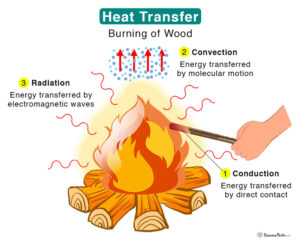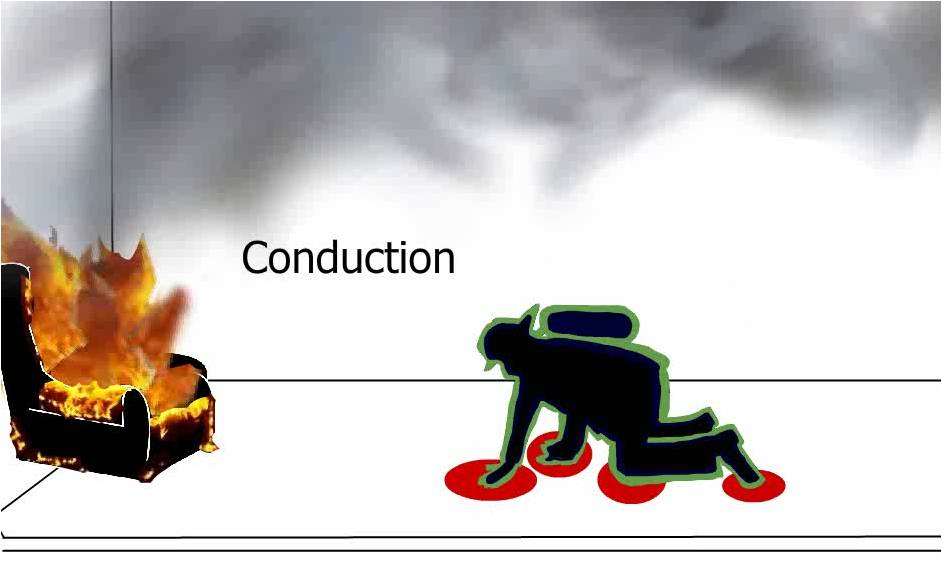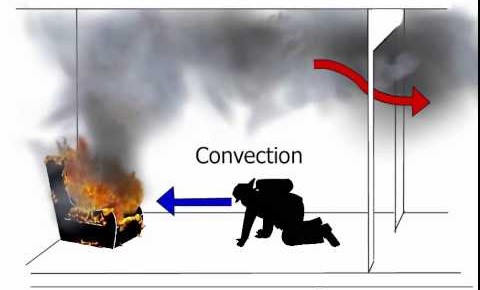In the realm of fire investigation, understanding heat transfer is crucial. Heat transfer plays a significant role in how fires start, spread, and ultimately, how they can be analyzed and investigated. There are three primary modes of heat transfer: conduction, convection, and radiation. In this article, we’ll delve into each of these modes and explore examples of how fire investigators can apply this knowledge to their work.
Conduction: Conduction is the transfer of heat through a solid material without the movement of the material itself. In other words, it occurs when heat travels through a substance by direct contact between molecules. Think of it as a domino effect, where one molecule transfers its energy to the next. The rate of conduction is dependent on the thermal conductivity (k) of the material and the size of the temperature differential.
Example for Fire Investigators: When investigating a fire scene, fire investigators often look for signs of heat transfer through conduction. For instance, they might examine the patterns of charred materials on surfaces to determine the direction of heat flow. Additionally, understanding how heat conducts through building materials (specifically metal beams which conduct heat well) can help investigators trace the path of the fire and identify potential points of origin.
Convection: Convection is the transfer of heat through the movement of fluids, such as liquids or gases. It occurs when heated particles become less dense and rise, while cooler particles sink, creating a circulation pattern. Convection can occur naturally, such as in the case of hot air rising, or it can be forced, as in the case of an air conditioning or heating system.
Example for Fire Investigators: Fire investigators often encounter convection as a significant factor in fire behavior. For instance, in a room fire, hot gases produced by the combustion process rise to the ceiling and then spread horizontally, heating up adjacent surfaces. Convection is also the means that spreads soot and other products of combustion to rooms with no direct flame impingement. Understanding convection patterns can help investigators determine the direction and intensity of the fire’s spread, aiding in reconstructing the sequence of events during a fire incident.
Radiation: Radiation is the transfer of heat through electromagnetic waves. Unlike conduction and convection, radiation does not require a medium to propagate; it can travel through a vacuum. Heat radiation is emitted in the form of infrared radiation and can be absorbed, reflected, or transmitted by various materials. Radiant energy can only be transmitted by line of sight and will be reduced or blocked by intervening objects.
Example for Fire Investigators: In fire investigation, radiation plays a crucial role in understanding fire behavior and its effects on surrounding objects. Radiation is a key component of flashover. Post flashover burning in a compartment can yield fire effects that mimic accelerated fire. In addition to Investigators, fire fighters can use thermal imaging cameras to detect radiation emitted by hot objects or areas. By analyzing these thermal signatures, fire fighters can identify hidden fire sources, and stop a potential rekindle.
Understanding the three modes of heat transfer—conduction, convection, and radiation—is essential for fire investigators. By recognizing how heat moves through different mediums, investigators can reconstruct fire dynamics, identify points of origin, and determine the cause of fires more accurately. Incorporating this knowledge into fire investigation practices enhances the efficiency and effectiveness of investigative efforts.
As President of The Warren Group, Jennifer Morningstar, B.S.Ch.E, P.E., CFEI, has over 20 years of engineering experience. A licensed professional engineer in several states and a NAFI Certified Fire and Explosion Investigator, she holds a Bachelor of Science Degree in Chemical Engineering from Virginia Polytechnic Institute and State University, as well as a Master of Business Administration from the University of South Carolina. Throughout her engineering career, Jennifer has conducted forensic investigations involving chemical release/exposure, OSHA process safety management, industrial accident investigation, equipment failures, fires & explosions, and scope of damage/cost to repair. Jennifer is a member of the National Association of Fire Investigators (NAFI), the South Carolina chapter of the International Association of Arson Investigators (SCIAAI), and the American Institute of Chemical Engineers (AIChE).







